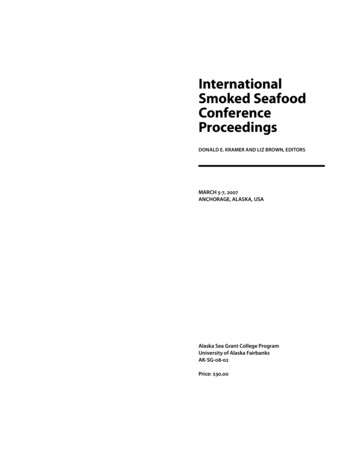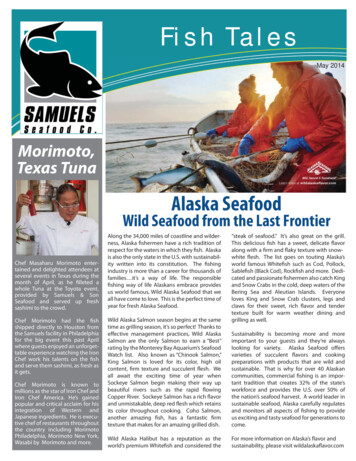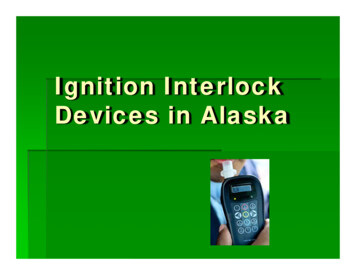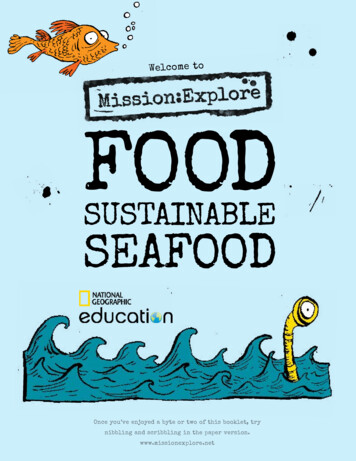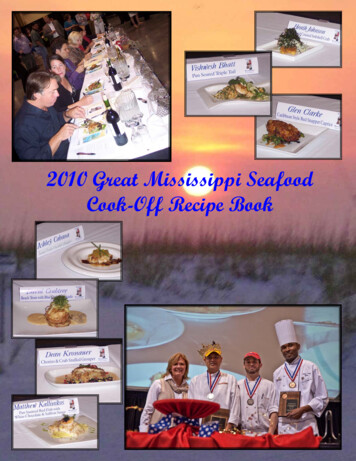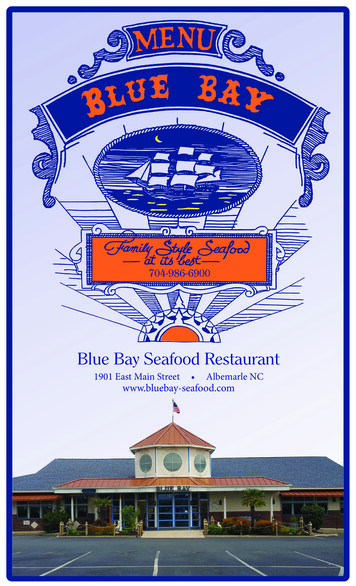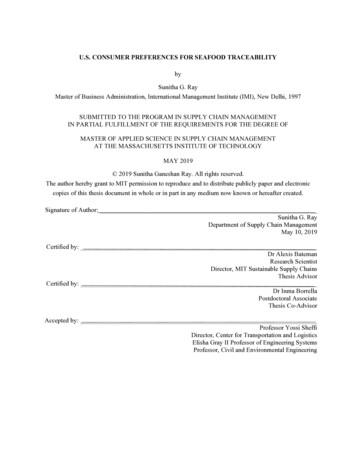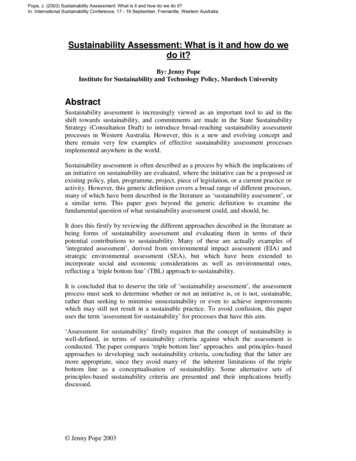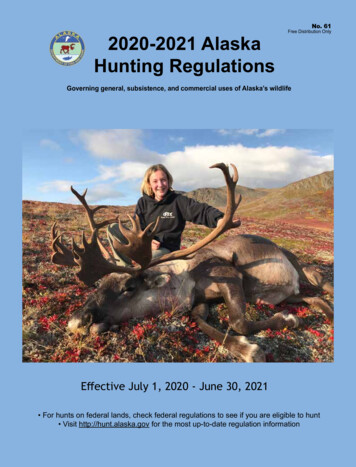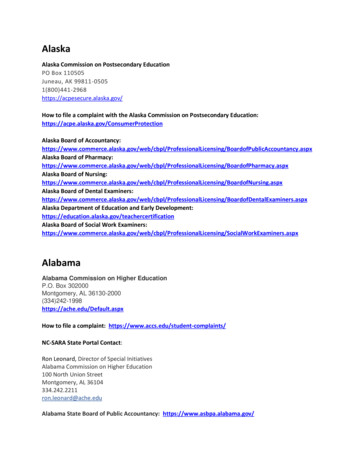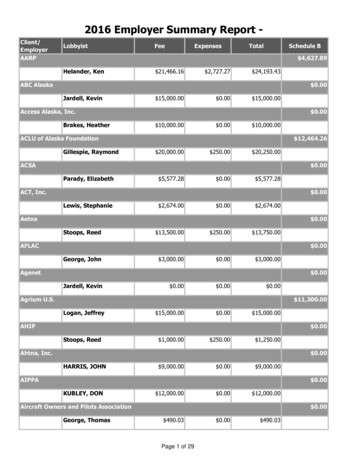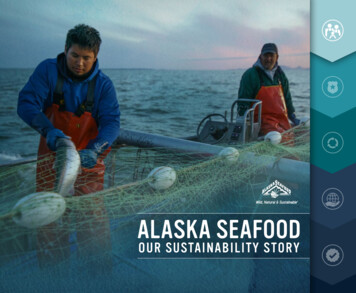
Transcription
ALASKA SEAFOODOUR SUSTAINABILITY STORY
Seek the gold standard in sustainabilityTHE FIVE PILLARSOF ALASKA SEAFOODSUSTAINABILITYTogether Alaska’s fivesustainability pillars tell thestory of the important workAlaska does to ensure thatsustainable Alaska seafoodlands on your plate.Find out more about eachpillar on the following pages.FAMILIES &COMMUNITIESASK FOR ALASKAFAMILIES &COMMUNITIESUnderstanding seafoodsustainability can be confusing.To make it easy, just ask forAlaska to guarantee you receivewild and sustainably caughtseafood.Alaska’s fishing families are theheart and soul of the Alaskaseafood industry, and as we handdown fishing practices fromgeneration to generation, we believepassionately in the importance ofWild seafood is one of Alaska’smost precious resourcesand our state goes to greatlengths to ensure its continuedabundance. From fishermenand processors to scientistsand law enforcement officials,sustainability is not only crucialto our livelihood, but a deeplyingrained tradition.Small, rural towns and villagespopulate many regions ofAlaska where commercialfishing is the primaryeconomic opportunity.sustainability.In fact, many communities’ wayof life depends on healthy wildfish stocks. That’s why Alaska’sfishermen and fishing communitiesare so dedicated to upholdingour strict fishing laws, usingsustainable harvesting methods,and adhering to the latest scientificdata and other robust fisheriesmanagement IALRESPONSIBILITYMost of Alaska’s 9000 fleetThe seafood industry is theCERTIFICATIONBELONG TOMULTI-GENERATIONAL,SMALL FAMILY BUSINESSESLARGESTPRIVATE SECTOREMPLOYER IN ALASKA
FISHERIESMANAGEMENTAlaska pioneered applying successful,science-based sustainable managementpractices and serves as the goldstandard for fisheries around theworld.State, federal and internationalmanagement agencies share thegoal of sustainability; each has alegal mandate to prevent overfishingor harm to ecosystems and fishingcommunities.IN ALASKA, IT’STHE LAWAlaska takes a scientific and precautionaryapproach to setting harvest levelsSustainable fishing has been thelaw since 1959 when Alaska becamethe only state with sustainabilitywritten into its constitutionTHIS MEANS WE CATCH FAR LESSTHAN WHAT IS ALLOWEDHARVEST LIMIT EXAMPLE:30252015In other words, Alaska is notafraid to say “no” on restrictingall access to fishing becausethe fish always come first.Public participation by fishermen,seafood processors, and environmentalgroups is a key component for Alaska’sexcellent fisheries management.Inclusive collaboration with the publichelps build widespread understandingabout the importance of responsiblemanagement actions.Bering Sea/Aleutian Islands (BSAI) GroundfishBiomass - Total amount of fish in the areaof ocean of a particular fishery10502005 2006 2007 2008 2009 2010 2011 2012 2013 2014 2015 2016 2017 2018TOTAL BIOMASSTOTAL ABCTACScientists calculate the Acceptable Biological Catch (ABC) –the maximum number of fish that can be sustainably caught(a very small portion of the biomass)Fishery managers go a step further and set the Total AllowableCatch (TAC) – which is even lower than what the scientists haveset. The TAC never exceeds the ABC.
RESOURCEUTILIZATIONGenerations of Alaskans have along tradition of utilizing the entireresource. This goal now extendsto businesses where we strive formaximum use of our abundant supply.All parts of Alaska seafood like roe(fish eggs), collars and skin aretreasured in different markets aroundthe world. After primary processing,many Alaska seafood producers usethe remaining materials to createproducts such as fishmeal and fish oil.This increases the value and createsdiversity in the marketplace forAlaska seafood.Alaska strives to use100% OF EACH FISHAlaska pollock fishoil is used as fuel inremote processingfacilities.Mentaiko, picturedhere, is made fromthe cured roe ofAlaska pollock, and isa treasured delicacy.BONES: Used in pet food, fertilizer and toremove heavy metals and radioactivewaste from contaminated soil.MILT, STOMACHS & ROE: These are treasureddelicacies and are highly valued asspecialty products worldwide.SKIN: Have healing properties, are used intextiles, and biodegradable “plastic” canbe made from fish scales.OIL: A great source of heart-healthyomega-3 fatty acids DHA & EPA, oftenused in vitamin supplements.BONESMILTROESKINOIL
SOCIALRESPONSIBILITYWhile protecting the environmentand fish is of utmost importance,in Alaska, protections extend to thepeople as well.We ensure safe and fair workingconditions and livelihood securityfor the people employed in theAlaska seafood industry and forrural communities who dependon fishing for food to feed theirfamilies and cultural practices.The seafood industry servesas a cornerstone of the Alaskaeconomy and prioritizing socialresponsibility remains a keyelement of our business practices.WORKERS IN ALASKA AREPROTECTED UNDER MULTIPLELAWS AND ORGANIZATIONSIN ALASKA FOOD SECURITYTAKES PRIORITY OVERINDUSTRYFisheries in Alaska operate undera broad suite of federal and statelaws and regulations ensuringworkplace safety. Complianceis ensured through rigorousinspections and enforcement.Our fisheries management systemprioritizes subsistence fishing, whichis the customary and traditionalharvesting and use of wild seafoodfor food and cultural significance, animportant part of life in rural Alaska.
CERTIFICATIONCertification provides a way forfisheries to show responsiblefisheries management andstrong governance.RFM & MSC CERTIFICATIONRFM and MSC each have a Chain of Custodyprogram, providing assurance to buyers thatcertified fish can be traced through the supplychain back to its origin - a certified fishery.Certification measures againsta standard of best practices forhow fisheries are sustainablymanaged and provides a highlevel of assurance that theseafood you purchase is verifiedas sustainable or responsible,was harvested legally, and istraceable back to its source.Alaska demonstrates thisthrough dual independent,third party sustainable seafoodcertifications - ResponsibleFisheries Management (RFM)and Marine Stewardship Council(MSC).Both programs are benchmarked by theGlobal Sustainable Seafood Initiative (GSSI)and aligned with the United Nations Foodand Agriculture Organization (FAO) Code ofConduct for Responsible Fisheries, the mostcomprehensive set of international standardsand best practices for wild fisheries.JOURNEY OF CERTIFICATIONFISHERY TO PLATEFISHERYCERTIFICATIONCHAIN OF CUSTODYCERTIFICATIONPRODUCTLICENSING
What isSUSTAINABLE, WILD SEAFOOD?It’s seafood responsibly managed to exist long-term without compromising the survivalof the species or the health of the surrounding ecosystem.Sustainable seafood is the most environmentally efficient source of protein on the planet.Did you know?Did you know?ALASKA HAS NEVER HAD ASPECIES ON THE ENDANGEREDSPECIES LISTALASKA’S REGULATIONSARE BUILT TO PROTECT THEECOSYSTEMHow? We prioritize the needs ofthe ecosystem over the harvest.· Time-and-area closures· Restrictions on boat size & certain fishing gear· Prohibiting certain types of fishing gear· License limitationsALASKA SEAFOOD MARKETING INSTITUTE ALASKASEAFOOD.ORG ALASKASEAFOOD.ORG/RFM-CERTIFICATION 2020 ASMI
groups is a key component for Alaska's excellent fisheries management. Inclusive collaboration with the public helps build widespread understanding about the importance of responsible management actions. IN ALASKA, IT'S THE LAW Sustainable fishing has been the law since 1959 when Alaska became the only state with sustainability
